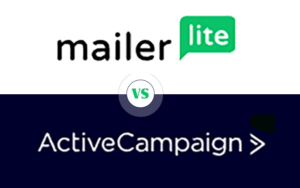Choosing the right email marketing platform is a crucial decision for any business looking to enhance its online presence and customer engagement. Two of the most popular options on the market are Mailchimp and MailerLite. Both platforms offer a wide range of features designed to help businesses create, manage, and optimize their email marketing campaigns. However, they differ significantly in terms of functionality, ease of use, pricing, and AI-driven capabilities. In this guide, we’ll explore the key differences between Mailchimp vs MailerLite to help you determine which platform best suits your needs.
Table of Contents
Overview of Mailchimp vs MailerLite
When it comes to choosing an email marketing platform, Mailchimp and MailerLite are two of the most popular options on the market. Both platforms offer a range of features designed to help businesses of all sizes manage their email marketing campaigns effectively. However, understanding the key differences between Mailchimp vs MailerLite can help you decide which platform is the best fit for your needs. In this overview, we’ll compare these two tools in terms of ease of use, features, pricing, and support.
1. Ease of Use
Mailchimp: Mailchimp is known for its robust set of features, but with that comes a slightly steeper learning curve, especially for beginners. The platform offers a wide variety of tools and integrations, which can be overwhelming for new users. However, once you get the hang of it, Mailchimp’s interface is intuitive and powerful, allowing you to manage complex campaigns with ease.
MailerLite: MailerLite, on the other hand, is praised for its simplicity and ease of use. It’s designed with beginners in mind, offering a clean and straightforward interface that makes it easy to get started quickly. Even though it may not have as many advanced features as Mailchimp, MailerLite excels in making email marketing accessible to everyone.
Mailchimp Dashboard Options vs MailerLite Dashboard Options
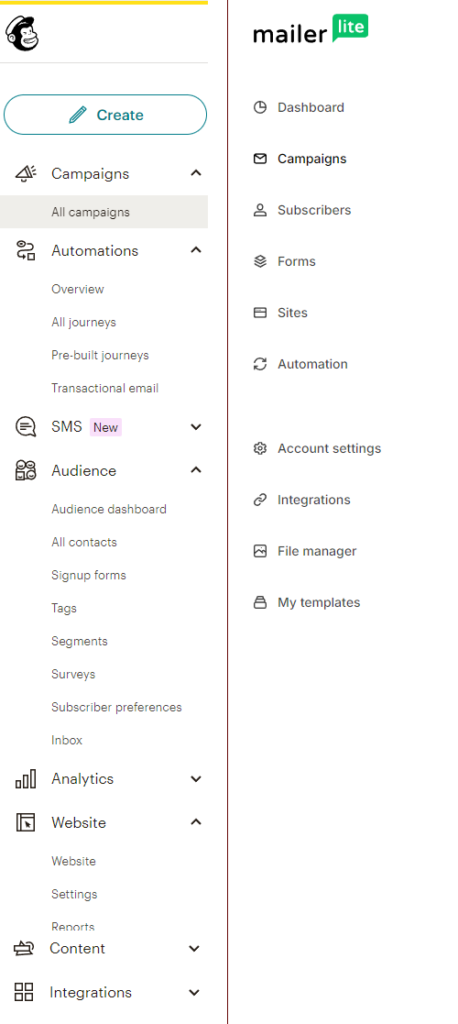
2. Features
Mailchimp: Mailchimp provides a comprehensive suite of features, including advanced automation, detailed audience segmentation, A/B testing, and extensive analytics. It also offers a wide range of integrations with third-party apps, making it a versatile tool for businesses that require a high level of customization.
MailerLite: MailerLite offers a solid set of features that cover the essentials of email marketing, such as drag-and-drop email creation, basic automation, and landing page creation. While it may lack some of the advanced capabilities of Mailchimp, MailerLite’s features are more than sufficient for small businesses or those with straightforward email marketing needs.
Example of Key Features Comparing Mailchimp vs MailerLite
(Detailed discussion below)
| Mailchimp | MailerLite | |
| Overall Difference | Comprehensive suite of tools that cater to businesses of all sizes | Simple, budget-friendly tool |
| Target Audience | Suited for large businesses with complex needs | Ideal for small to medium-sized businesses |
| Free Plan | Yes | Yes |
| Pricing | Paid plans primarily based features offered | Pricing primarily based on the number of subscribers. |
| Ease of Use | Has a more complex interface with many options | Has clean and intuitive interface |
| Workflows | More complex workflows and a wide range of triggers based on user behavior | Allows users to set up simple workflows |
| Templates and Design Flexibility | Wide range of professionally designed templates and allows for more customizaation | Good selection of templates, but more focused on simplicity |
| Audience Segmentation | Can segment their lists based on a wide range of criteria | Users can segment their lists based on simple criteria |
| Reporting and Analytics | Detailed analytics and comprehensive reports | Essential analytics and useful reports |
3. Pricing
Mailchimp: Mailchimp’s pricing can be higher, especially as your subscriber list grows or if you need access to more advanced features. It offers a free plan with limited features, but as your needs increase, so does the cost. This can be a significant factor for small businesses or those on a tight budget.
MailerLite: MailerLite is known for its affordability, with straightforward pricing plans that are often more budget-friendly than Mailchimp. It also offers a free plan, which includes access to most of its features, making it an attractive option for businesses looking for cost-effective email marketing solutions.
Comparison of Mailchimp vs MailerLite Pricing
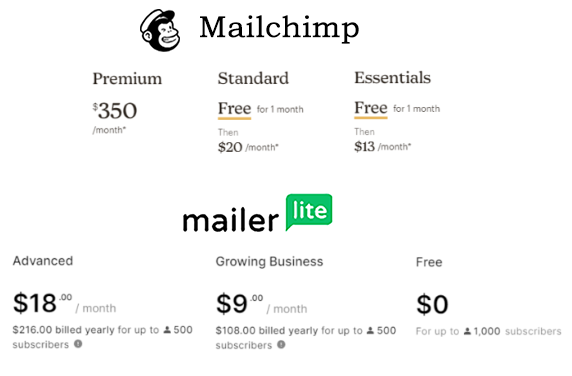
4. Customer Support
Mailchimp: Mailchimp offers a range of support options, including email and chat support, as well as a comprehensive help center with articles, guides, and tutorials. However, access to some support features may be limited depending on your pricing plan.
MailerLite: MailerLite is well-regarded for its responsive customer support, offering 24/7 email support and live chat during business hours. It also has an extensive library of resources to help users get the most out of the platform.

Conclusion: Overview of Mailchimp vs MailerLite
In the battle of Mailchimp vs MailerLite, the right choice depends on your business needs, budget, and level of experience with email marketing. Mailchimp offers more advanced features and integrations, making it suitable for larger businesses or those with complex marketing strategies. MailerLite, with its ease of use and affordable pricing, is ideal for small businesses, startups, or anyone new to email marketing.
By understanding the differences between Mailchimp vs MailerLite, you can choose the platform that best aligns with your marketing goals and start building effective email campaigns that drive results.
Comparing Pricing Plans: Mailchimp vs MailerLite
When choosing an email marketing platform, pricing is a crucial consideration. In this section, we’ll break down the pricing plans of Mailchimp vs MailerLite to help you decide which platform offers the best value for your needs.
Mailchimp Pricing
Mailchimp offers a range of pricing options to cater to businesses of different sizes:
- Free Plan: Mailchimp’s Free Plan includes basic tools for up to 500 contacts and 1,000 monthly email sends. This plan is suitable for individuals or small businesses just starting out, but it has limited features.
- Essentials Plan: Starting at $13/month, this plan allows for up to 5,000 monthly email sends to 500 contacts and includes access to all email templates, A/B testing, and customer support. It’s a good option for small businesses needing more flexibility and features.
- Standard Plan: For $20/month, this plan offers up to 6,000 email sends to 500 contacts, along with advanced automation, enhanced analytics, and more robust audience segmentation. It’s designed for growing businesses that require more sophisticated marketing tools.
- Premium Plan: Starting at $350/month, this plan is designed for large businesses and includes advanced features like multivariate testing, priority support, and 150,000 email sends per month to 10,000 contacts.
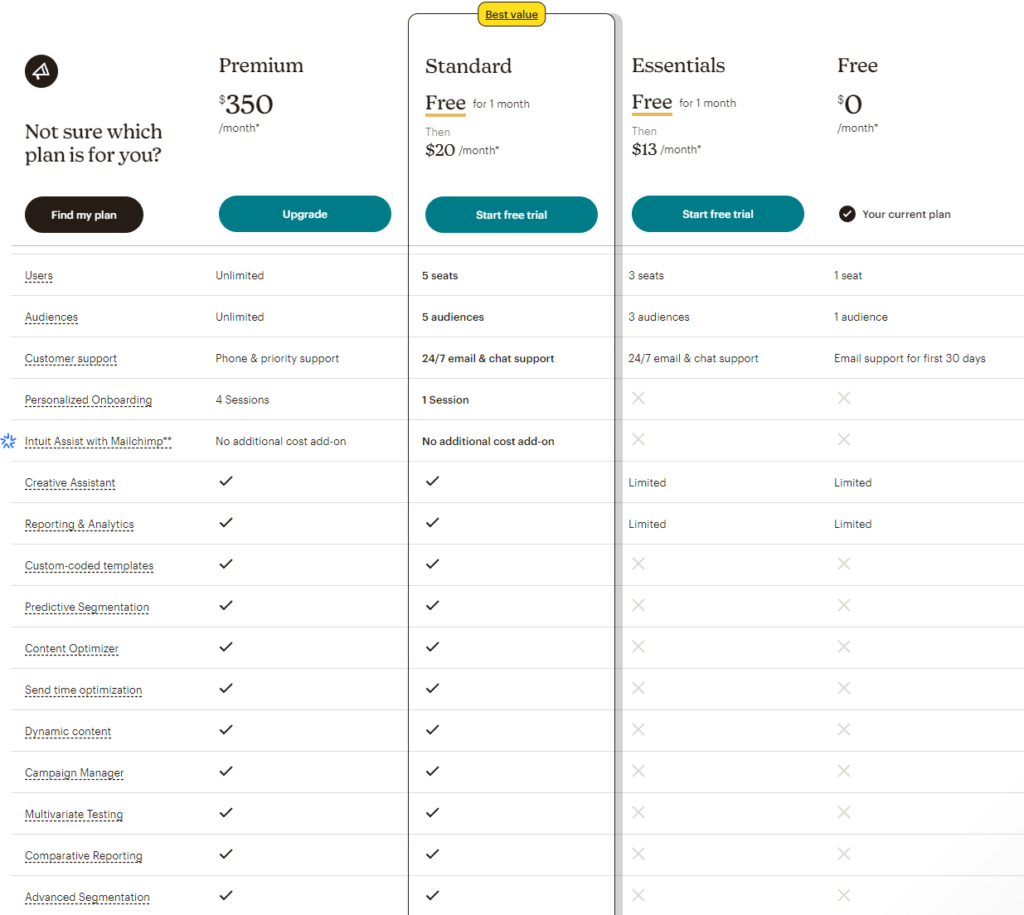
MailerLite Pricing
MailerLite is known for its simplicity and affordability:
- Free Plan: MailerLite’s Free Plan allows up to 12,000 emails per month to 1,000 contacts, offering more generous limits than Mailchimp’s free plan. This plan includes essential tools like the drag-and-drop editor, basic automation, and A/B testing.
- Growing Business Plan: Starting at $9/month, this plan includes unlimited email sends, access to more advanced features like automation workflows, and priority customer support. It’s ideal for small to medium-sized businesses.
- Advanced Plan: Priced at $18/month, this plan offers additional integrations and features such as advanced reporting, dedicated IP, and Facebook integration, making it suitable for growing businesses with more complex needs.
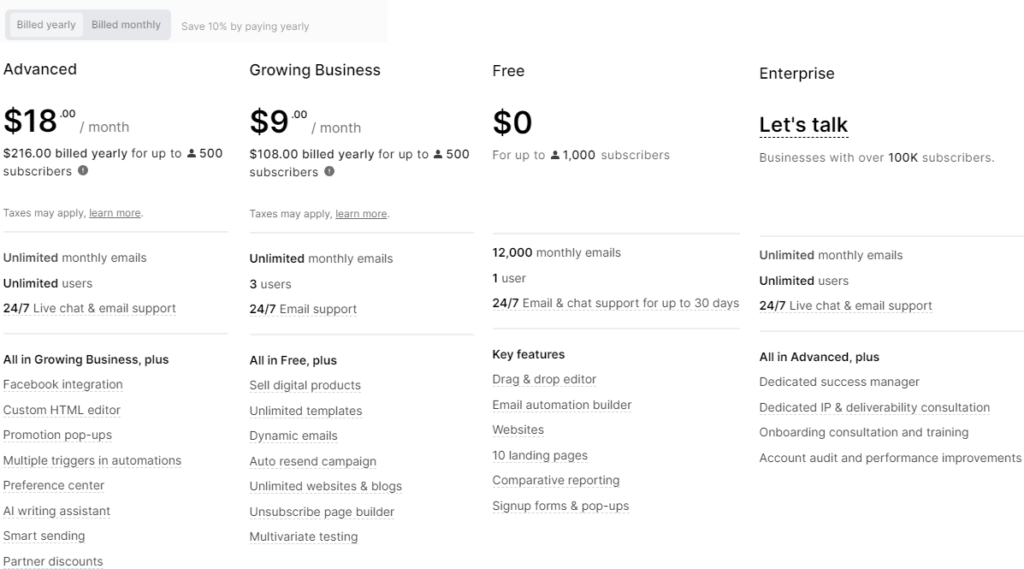
Which is More Cost-Effective?
When comparing the cost-effectiveness of Mailchimp vs MailerLite, MailerLite clearly stands out as the more affordable option, especially for small to medium-sized businesses or those just getting started with email marketing. While Mailchimp offers more advanced features, these come at a higher cost, which may not be justifiable for businesses with simpler needs. If your priority is to get the most value for your money, MailerLite is likely the better choice.
Email Marketing Features Showdown: Mailchimp vs MailerLite

When it comes to choosing the right email marketing platform, two popular options often come to mind: Mailchimp and MailerLite. Both platforms offer a robust set of features that cater to businesses of all sizes, but understanding their differences can help you decide which one is better suited for your needs. In this article, we’ll compare the key email marketing features of Mailchimp vs MailerLite to help you make an informed decision.
1. Email Creation Tools
Mailchimp: Mailchimp offers a robust drag-and-drop editor that allows users to create highly customizable email campaigns. With a vast library of templates and a content studio for storing images and files, Mailchimp is designed to cater to users who want full control over their email design. Advanced users can also edit HTML directly, providing even more flexibility.
Mailchimp Editor
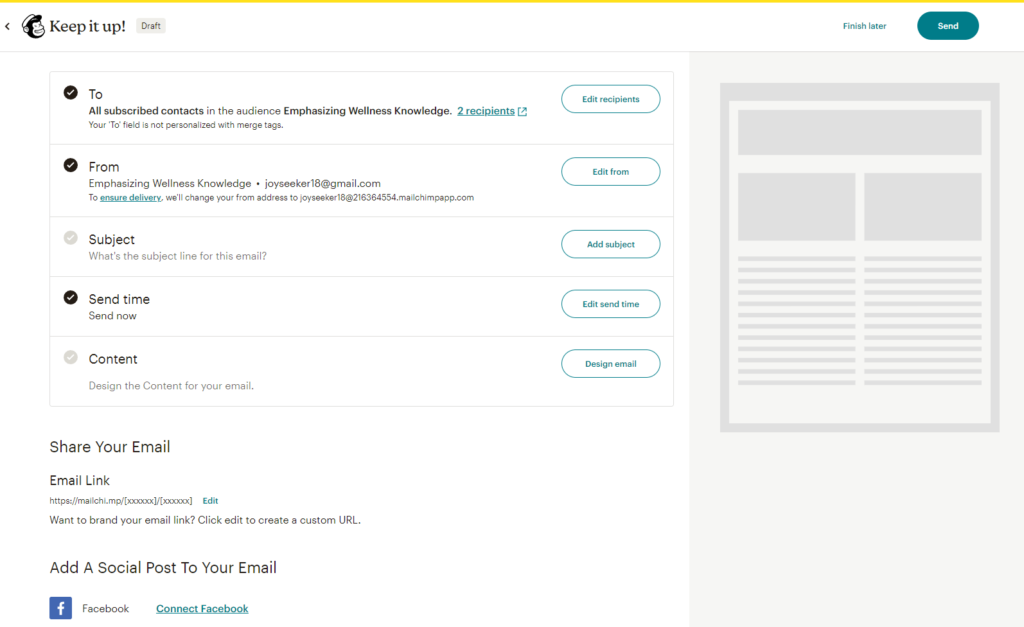
MailerLite: MailerLite also provides a drag-and-drop editor, but it’s known for its simplicity and ease of use. The platform offers a range of templates, though fewer in number compared to Mailchimp. MailerLite’s editor is intuitive, making it a great choice for users who prefer a straightforward, no-fuss approach to email design.
MailerLite Editor
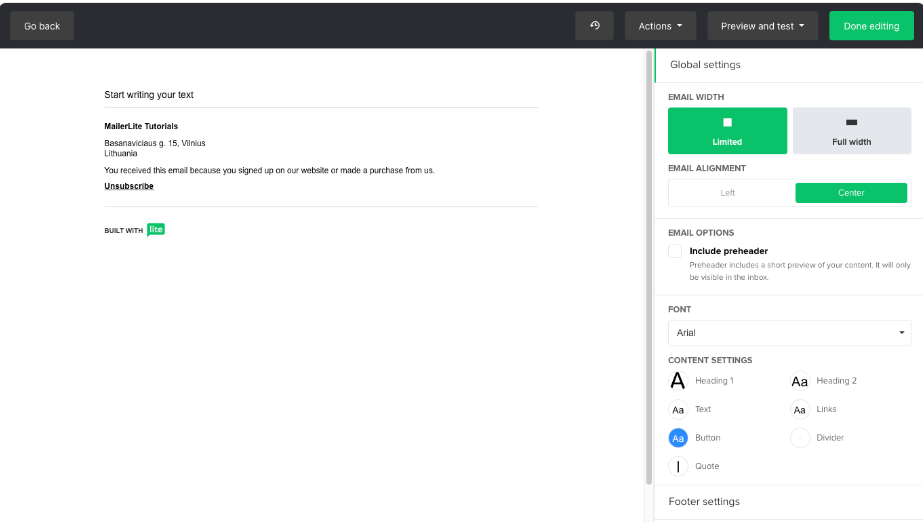
2. Automation Capabilities
Mailchimp: Mailchimp excels in automation, offering advanced features like customer journey mapping, which allows you to create highly personalized workflows based on user behavior. You can set up complex email sequences triggered by actions such as purchases, sign-ups, or specific dates, making it ideal for businesses with intricate marketing strategies. MailChimp calls these automations journeys.
Mailchimp Automation Dashboard

MailerLite: MailerLite offers essential automation features, allowing users to set up simple workflows based on customer actions. While it doesn’t have the depth of automation options that Mailchimp offers, it covers the basics well, making it suitable for smaller businesses or those with straightforward automation needs.
MailerLite automation dashboard

3. Audience Management
Mailchimp: Mailchimp offers advanced audience management features, including segmentation, tagging, and an audience dashboard that gives you detailed insights into your subscribers. This allows for more precise targeting and personalization in your email campaigns.
MailerLite: MailerLite provides similar audience management tools, but with a focus on simplicity. You can segment your audience and use tags to organize your contacts, but the level of detail and customization may not be as extensive as Mailchimp.
Mailchimp vs MailerLite Audience Management Comparison
| Feature | Mailchimp | MailerLite |
|---|---|---|
| Audience Segmentation | Advanced segmentation based on behavior, demographics, and more | Basic segmentation with essential criteria |
| Tags and Groups | Supports tags and groups for detailed audience organization | Supports tags and segments for organizing contacts |
| Advanced Targeting | AI-driven audience targeting and predictive analytics | Manual targeting based on user-defined segments |
| Subscriber Management | Robust management tools, including suppression lists | Simple subscriber management with easy list cleaning |
| Audience Dashboard | Detailed insights and analytics on audience behavior | Basic dashboard with key metrics and insights |
| Personalization | Dynamic content and personalized recommendations | Basic personalization using subscriber data |
4. Analytics and Reporting
Mailchimp: Mailchimp’s analytics and reporting tools are comprehensive, offering detailed insights into your campaign performance. You can track open rates, click-through rates, and even integrate with your e-commerce platform to measure sales and revenue generated from your emails.
MailerLite: MailerLite also provides solid reporting features, including basic analytics such as open rates and click rates. However, it might lack some of the advanced reporting options available in Mailchimp, particularly for more complex e-commerce tracking.
Mailchimp vs MailerLite Analytics and Reporting Comparison
| Feature | Mailchimp | MailerLite |
|---|---|---|
| Reporting Dashboard | Comprehensive dashboard with detailed metrics | Simple, easy-to-use dashboard with essential metrics |
| Email Performance Metrics | Advanced metrics including open rates, click rates, conversions, and more | Basic metrics like open rates, click rates, and unsubscribes |
| A/B Testing Reports | In-depth A/B testing reports with multiple variables | Basic A/B testing reports |
| E-commerce Tracking | Detailed e-commerce tracking including sales and revenue attribution | Basic e-commerce tracking integrated with popular platforms |
| Predictive Analytics | AI-driven predictive analytics for campaign success | Not available |
| Exporting Reports | Exportable reports in multiple formats | Exportable reports, but with fewer customization options |
5. Integrations
Mailchimp: One of Mailchimp’s strengths is its wide range of integrations. It connects seamlessly with numerous third-party apps, including e-commerce platforms, CRMs, and social media channels, providing more flexibility for users who need to integrate their email marketing with other tools.
Mailchimp Featured Integrations

MailerLite: MailerLite offers a decent range of integrations but is generally more limited compared to Mailchimp. However, it covers the most essential apps, making it suitable for smaller businesses with less complex needs.
MailerLite Featured Integrations

6. Pricing and Value
While not strictly a feature, pricing is a critical factor when comparing Mailchimp vs MailerLite. Mailchimp offers a free plan, but its pricing can quickly increase as your subscriber list grows or if you need access to more advanced features. MailerLite, on the other hand, is known for its affordability and straightforward pricing structure, making it a popular choice for budget-conscious users.
Conclusion: Which is Right for You?
When comparing Mailchimp vs MailerLite, the best choice largely depends on your specific needs and the complexity of your email marketing efforts. Mailchimp offers more advanced features and integrations, making it a strong choice for larger businesses or those with complex marketing needs. On the other hand, MailerLite’s simplicity, ease of use, and affordability make it an excellent option for small businesses or those new to email marketing.
By understanding the differences in their email marketing features, you can choose the platform that aligns with your business goals and start building successful email cam
Landing Pages: Mailchimp vs MailerLite
Landing pages are a crucial component of any digital marketing strategy, serving as the first point of contact for potential customers and a tool for capturing leads. Using the Landing Pages feature as an example, we will show the clear differences between each program’s approach to the feature. Both Mailchimp and MailerLite offer landing page creation features, but they cater to different needs and levels of experience. In this comparison of Mailchimp vs MailerLite, we’ll explore how each platform approaches landing pages, helping you decide which one is better suited for your business.
1. Ease of Use
Mailchimp: Mailchimp offers a user-friendly landing page builder that integrates seamlessly with its other marketing tools. The drag-and-drop editor allows you to create visually appealing landing pages without needing to know how to code. Mailchimp provides a range of pre-designed templates that you can customize to match your brand, making it easy to set up landing pages quickly.
Mailchimp Landing Page Builder
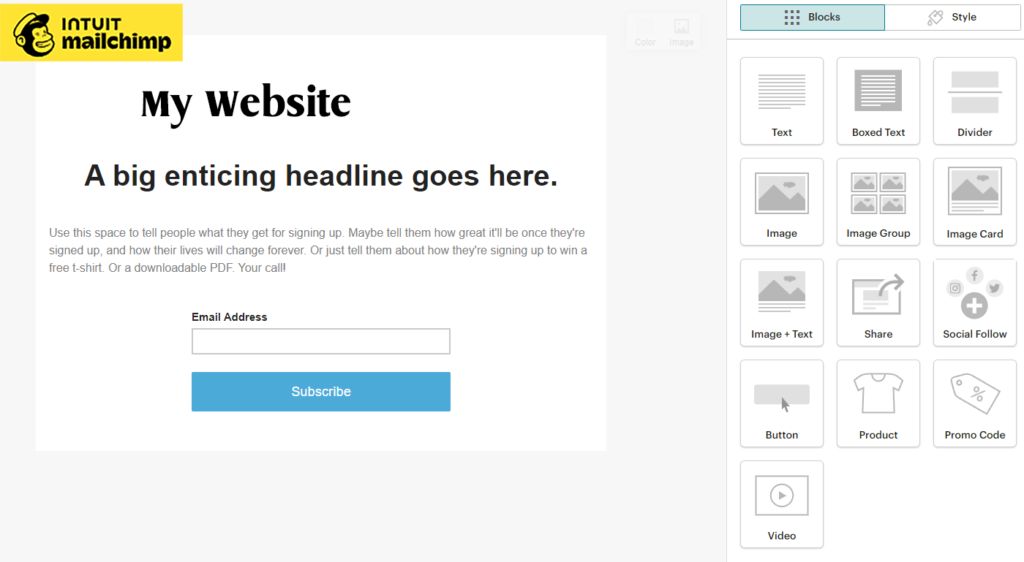
MailerLite: MailerLite’s landing page builder is also designed with simplicity in mind. It features a straightforward drag-and-drop editor similar to Mailchimp’s, but with an emphasis on ease of use. MailerLite offers fewer templates compared to Mailchimp, but the templates provided are clean and modern, perfect for users who prefer a minimalist approach.
MailerLite Landing Page Builder
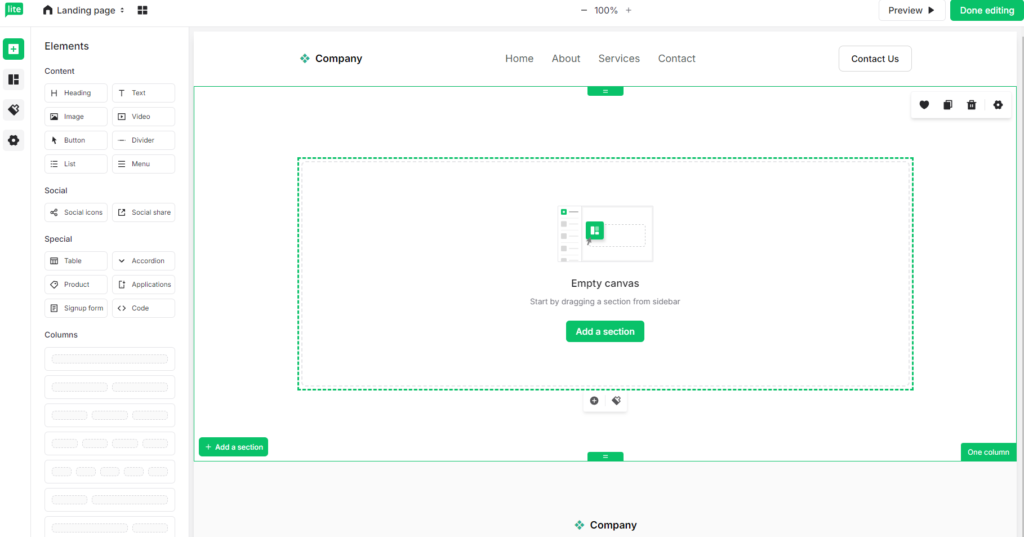
2. Customization Options
Mailchimp: Mailchimp provides a wide array of customization options, allowing you to adjust everything from fonts and colors to layout and images. You can also add elements like forms, videos, and social media links, giving you full control over the look and functionality of your landing pages. This makes Mailchimp a strong choice for users who need a high level of customization.
MailerLite: MailerLite offers basic customization options that cover the essentials, such as changing colors, fonts, and adding basic elements like forms and images. While it may not offer as many customization features as Mailchimp, MailerLite’s simplicity is ideal for users who want to create effective landing pages without getting bogged down in too many options.
Mailchimp vs MailerLite Customization Options Comparison
| Feature | Mailchimp | MailerLite |
|---|---|---|
| Email Templates | Extensive library of customizable templates | A variety of simple, modern templates |
| Drag-and-Drop Editor | Advanced drag-and-drop editor with detailed customization options | User-friendly drag-and-drop editor with basic customization |
| HTML/CSS Editing | Full HTML/CSS editing for complete control | Basic HTML editing, more limited than Mailchimp |
| Dynamic Content | Supports dynamic content blocks for personalized emails | Supports basic dynamic content for personalization |
| Branding Customization | Extensive options for customizing branding elements | Basic branding customization, covers essential needs |
| Landing Page Customization | Highly customizable landing page builder | Simple, effective landing page customization |
3. Integration with Email Marketing
Mailchimp: One of Mailchimp’s strengths is its ability to integrate landing pages directly with your email marketing campaigns. You can easily connect your landing pages to your email lists, ensuring that any leads captured are automatically added to your Mailchimp audience. This integration makes it easier to create automated email sequences triggered by actions taken on your landing pages.
MailerLite: MailerLite also integrates landing pages with its email marketing tools, allowing you to seamlessly add new leads to your subscriber lists. While the integration is straightforward, it’s slightly less advanced than Mailchimp’s, focusing more on simplicity and ease of use. This makes it ideal for users who need basic, no-fuss email list management.
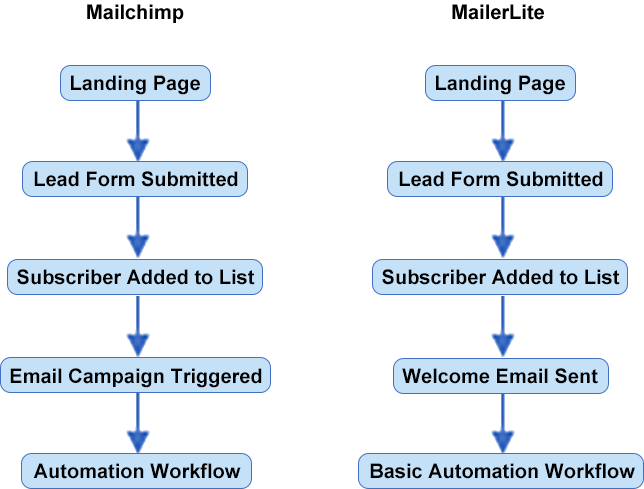
4. Analytics and Tracking
Mailchimp: Mailchimp offers robust analytics and tracking for landing pages, allowing you to monitor page performance, conversion rates, and visitor behavior. These insights can help you refine your landing pages over time to increase effectiveness. Mailchimp also integrates with Google Analytics, providing even deeper insights into your audience’s behavior.

MailerLite: MailerLite provides essential analytics for landing pages, such as views, clicks, and conversions. While the analytics tools are more basic compared to Mailchimp, they are easy to understand and sufficient for most small to medium-sized businesses. MailerLite also offers integration with Google Analytics for more detailed tracking.
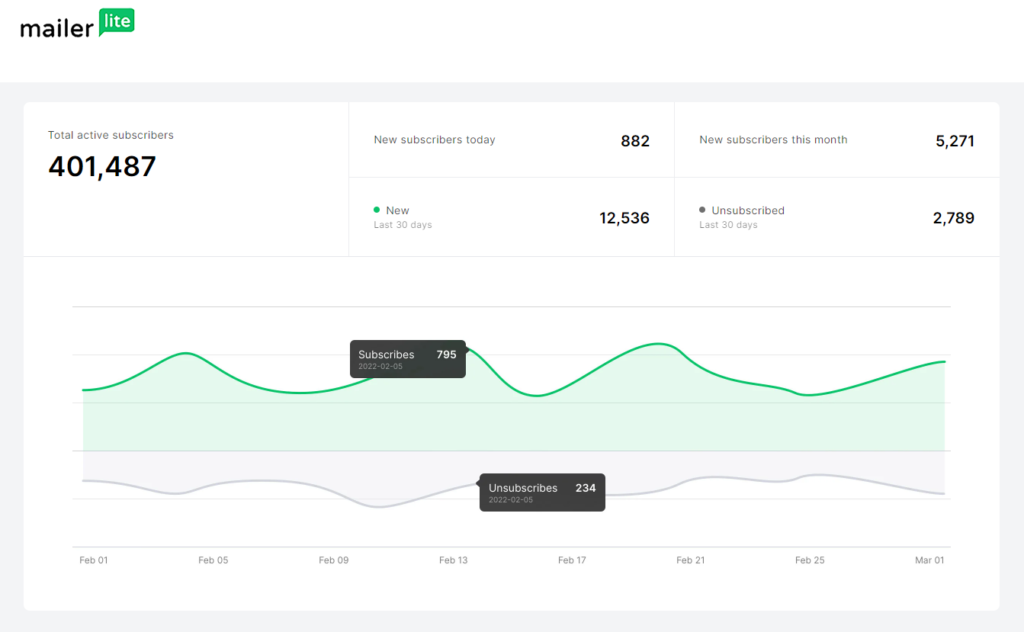
5. Conversion-Focused Features
Mailchimp: Mailchimp offers several features designed to enhance conversion rates on your landing pages, such as A/B testing, which allows you to test different versions of a page to see which one performs better. You can also add pop-ups and forms to capture leads more effectively. These tools make Mailchimp a powerful option for users focused on optimizing conversions.
MailerLite: MailerLite includes basic conversion-focused features, such as customizable forms and the ability to add pop-ups to your landing pages. While it may not have as many advanced options as Mailchimp, MailerLite’s tools are effective for users looking to capture leads without complex setups.
| Conversion Feature | Mailchimp | MailerLite |
|---|---|---|
| Forms | Advanced form builder with customizable fields, styling options, and embedded forms. Integration with CRM tools and advanced tracking for form submissions. | Simple and easy-to-use form builder with essential customization options. Includes embedded forms and basic tracking features. |
| Pop-ups | Extensive pop-up creation options with triggers based on user behavior (e.g., exit intent, scroll percentage). Customizable design and integration with automation workflows. | Basic pop-up builder with options for timing and triggers, such as entry, exit, or delay. Customizable templates, but fewer advanced triggers compared to Mailchimp. |
| A/B Testing | In-depth A/B testing capabilities for landing pages, forms, and emails. Allows for testing multiple variations with detailed analytics on performance and conversion rates. | Basic A/B testing features, primarily focused on email campaigns. Limited options for testing landing page variations or forms compared to Mailchimp. |
Conclusion: Landing Pages with Mailchimp vs MailerLite
In the comparison of Mailchimp vs MailerLite for landing pages, the right choice depends on your specific needs and the level of customization and integration you require. Mailchimp offers more advanced customization, integration, and analytics features, making it a strong choice for businesses with complex landing page needs and a focus on conversions. MailerLite, with its emphasis on simplicity and ease of use, is ideal for users who want to create effective landing pages quickly without needing extensive technical knowledge.
By understanding how Mailchimp and MailerLite handle landing pages, you can choose the platform that aligns best with your business goals and start creating landing pages that drive results.
User Experience and Ease of Use: Mailchimp vs MailerLite
When selecting an email marketing platform, user experience and ease of use are critical factors, especially for businesses and individuals who want to get up and running quickly. In this comparison of Mailchimp vs MailerLite, we’ll explore how each platform approaches user experience and ease of use, helping you determine which one best suits your needs.
1. Onboarding Process
Mailchimp: Mailchimp offers a comprehensive onboarding process that guides users through setting up their account, creating their first campaign, and understanding the platform’s key features. However, due to the extensive range of tools and options available, new users may find the learning curve slightly steeper, especially if they are unfamiliar with email marketing.
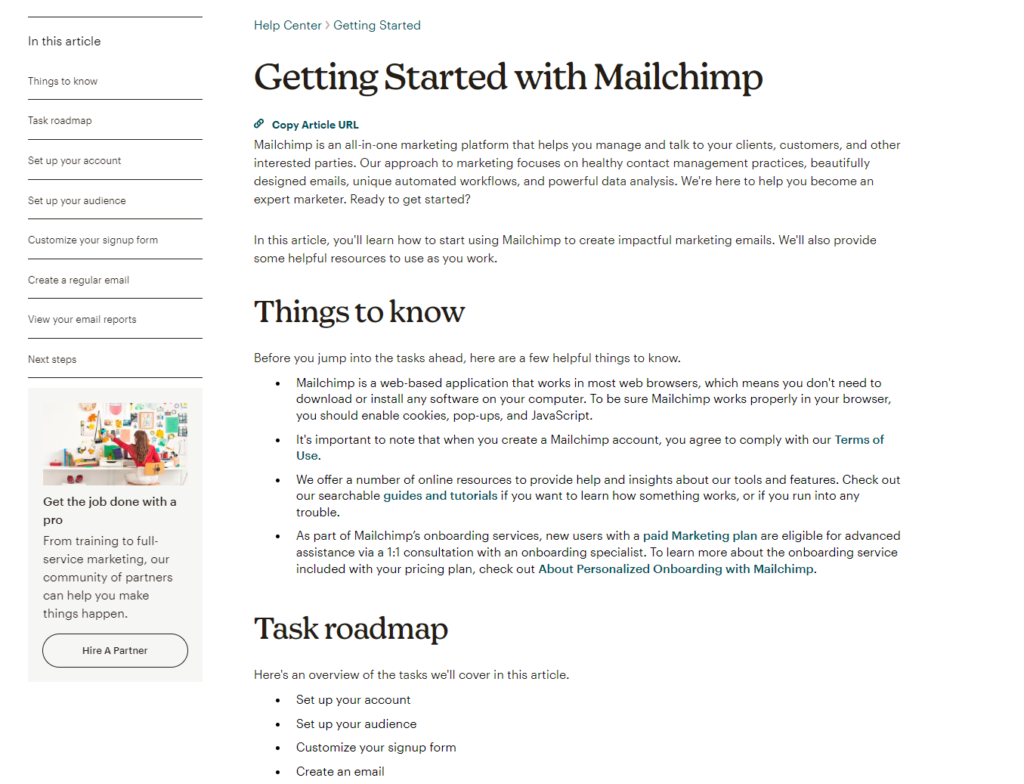
MailerLite: MailerLite is designed with simplicity in mind, and this is evident from the moment you sign up. The onboarding process is straightforward, walking you through the basics without overwhelming you with too many options. For users who prioritize ease of use and want to get started quickly, MailerLite’s onboarding process is refreshingly simple.
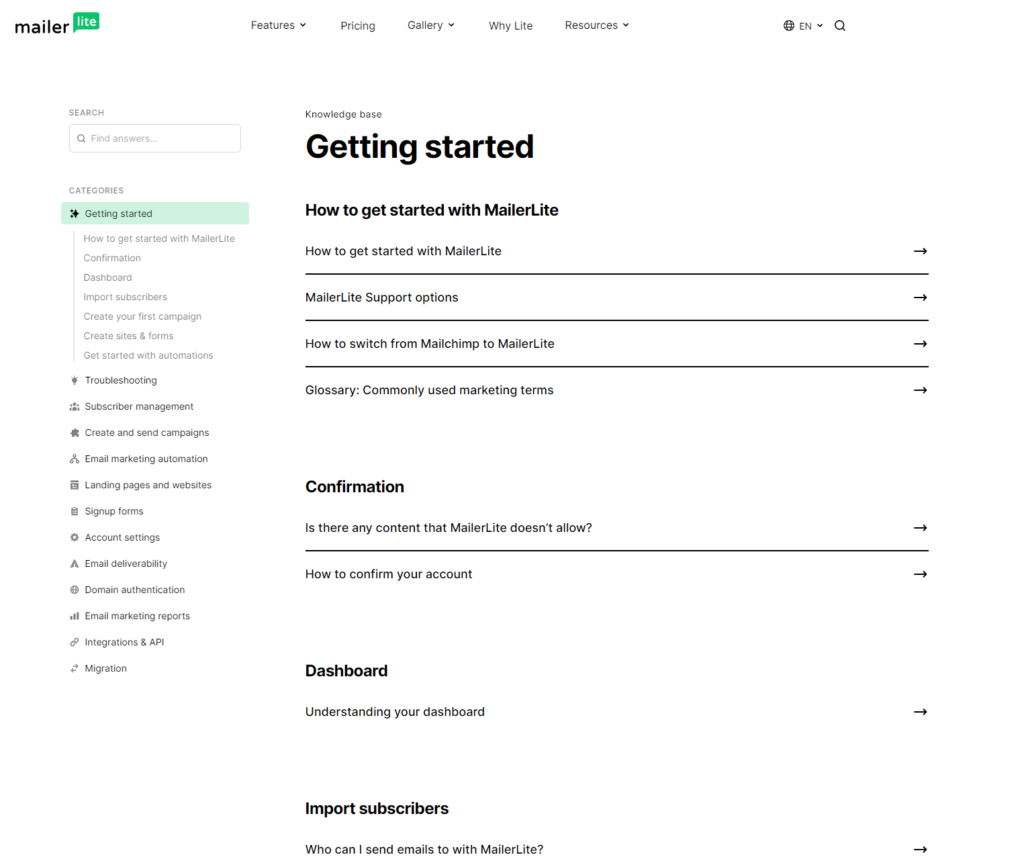
2. Interface Design
Mailchimp: Mailchimp’s interface is sleek and modern, offering a wide range of tools organized into different sections. While the design is visually appealing, the abundance of features can sometimes make the interface feel cluttered, particularly for new users who might not need all of the advanced options right away. However, for experienced marketers, this level of detail and customization is a significant advantage.
MailerLite: MailerLite’s interface is clean and minimalist, focusing on delivering a user-friendly experience. The layout is intuitive, with all the essential tools easily accessible from the dashboard. This simplicity makes it easy for users to navigate the platform without feeling overwhelmed, making MailerLite a great choice for beginners or those who prefer a more streamlined experience.

3. Learning Curve
Mailchimp: Due to its extensive feature set, Mailchimp has a steeper learning curve, particularly for users who are new to email marketing or digital marketing in general. While Mailchimp offers plenty of tutorials, guides, and support resources to help users get up to speed, it may take some time to become fully proficient with all of its capabilities.
MailerLite: MailerLite is known for its user-friendly approach, with a much shorter learning curve. The platform is designed to be intuitive, allowing users to start creating campaigns quickly without needing extensive training. For those who prefer a “learn by doing” approach, MailerLite’s straightforward design and helpful tooltips make it easy to pick up.
The typical user journey from sign-up to campaign creation for Mailchimp vs MailerLite
| Stage | Mailchimp | MailerLite |
|---|---|---|
| Sign-Up Process | Mailchimp offers a detailed sign-up process where users select their plan, input business details, and go through several onboarding steps to personalize the experience. The process is thorough, ensuring that the platform tailors its features to your specific needs. | MailerLite has a quick and straightforward sign-up process, focusing on getting users into the platform with minimal friction. Users can set up their account quickly, with simple steps to get started. The onboarding process is light, allowing users to explore the platform at their own pace. |
| Dashboard Overview | After signing up, Mailchimp presents a comprehensive dashboard with a range of options. The dashboard may seem overwhelming at first, with numerous features and tools visible upfront. However, it provides a thorough overview of what you can do, with quick links to tutorials and support. | MailerLite provides a clean and minimalistic dashboard upon sign-up, highlighting the most essential tools and features. The interface is intuitive, focusing on simplicity and ease of navigation, making it easy for beginners to find their way around without feeling overwhelmed. |
| Creating a Contact List | In Mailchimp, creating a contact list involves multiple steps, including setting up audience segments, adding tags, and defining groups. The platform offers advanced options for segmentation and organization, catering to businesses with more complex needs. | In MailerLite, creating a contact list is a straightforward process. Users can import contacts or add them manually with minimal setup. The platform focuses on simplicity, offering basic segmentation and tagging options to organize contacts effectively. |
| Designing an Email Campaign | Mailchimp provides a rich set of tools for designing email campaigns, including a drag-and-drop editor, customizable templates, and advanced content blocks. Users can choose from various templates or start from scratch, with numerous customization options available. | MailerLite offers a simple drag-and-drop editor with essential customization options. Users can choose from a range of clean, modern templates, and the editing process is intuitive. While it may not have as many features as Mailchimp, it covers the basics well, making it easy to create professional-looking emails quickly. |
| Setting Up Automation | Mailchimp allows users to set up complex automation workflows, including triggers based on user behavior, personalized content, and multi-step journeys. This stage may require more time and understanding of the platform’s capabilities. | MailerLite offers basic automation features, allowing users to set up simple workflows like welcome emails or follow-up sequences. The automation setup is user-friendly, making it easy for those new to email marketing to get started without needing in-depth technical knowledge. |
| Campaign Review and Launch | Before launching, Mailchimp provides an in-depth campaign review, including content analysis, spam check, and optimization tips. Users can preview their emails on different devices and make adjustments as needed. | MailerLite provides a quick review process, focusing on essential checks like content and recipient lists. The platform emphasizes ease of use, allowing users to quickly launch their campaigns with confidence. |
| Post-Launch Analytics | Mailchimp offers detailed post-launch analytics, including open rates, click-through rates, conversion tracking, and predictive insights. Users can dive deep into the data to refine future campaigns. | MailerLite provides basic analytics that cover key metrics like open rates, click rates, and unsubscribes. While it lacks the depth of Mailchimp’s analytics, it offers enough information for users to assess the success of their campaigns and make adjustments. |
4. Support and Resources
Mailchimp: Mailchimp offers extensive support options, including a help center with articles, tutorials, and guides. Users on higher-tier plans also have access to email and chat support. While these resources are comprehensive, navigating them can sometimes be challenging due to the platform’s complexity, making it more suitable for users who are comfortable with self-learning.
MailerLite: MailerLite provides a range of support resources, including 24/7 email support and live chat during business hours. The platform’s help center is straightforward, with easy-to-follow guides and tutorials that are particularly helpful for beginners. MailerLite’s support is often praised for being responsive and user-friendly, making it an excellent choice for those who may need a bit more guidance.
| Support Option | Mailchimp | MailerLite |
|---|---|---|
| Email Support | Available for all users, 24/7 for higher-tier plans | Available 24/7 for all users |
| Live Chat Support | Available for paid plans, 24/7 for higher-tier plans | Available during business hours for all users |
| Phone Support | Available only for higher-tier plans | Not available |
| Knowledge Base | Comprehensive knowledge base with articles, tutorials, and guides | Extensive knowledge base with easy-to-follow guides |
| Community Forums | Active community forums available for all users | Smaller community forums, available for all users |
| Priority Support | Available on premium plans | Not available |
| Onboarding Support | Detailed onboarding process with tutorials and guides | Simple onboarding with basic setup guides |
Conclusion: User Experience and Ease of Use in Mailchimp vs MailerLite
When comparing Mailchimp vs MailerLite in terms of user experience and ease of use, the choice largely depends on your level of experience and your specific needs. Mailchimp offers a comprehensive suite of tools with a more complex interface, making it suitable for users who need advanced features and are willing to invest the time to learn the platform. On the other hand, MailerLite’s clean design, simple navigation, and short learning curve make it an excellent option for beginners or those who prioritize ease of use over advanced functionality.
By understanding how Mailchimp and MailerLite approach user experience and ease of use, you can choose the platform that aligns best with your workflow and comfort level, ensuring a smoother email marketing experience.
Deliverability Rates: Mailchimp vs MailerLite
Deliverability rates are a critical aspect of any email marketing campaign. Ensuring that your emails land in your subscribers’ inboxes rather than getting filtered into spam folders can significantly impact your campaign’s success. In this comparison of Mailchimp vs MailerLite, we’ll examine how these two platforms stack up in terms of deliverability rates, providing you with the insights needed to choose the best option for your business.
1. Deliverability Performance
Mailchimp: Mailchimp is widely recognized for its high deliverability rates, which typically range between 96-99%. This strong performance is attributed to Mailchimp’s rigorous compliance with email best practices, including the use of advanced spam filters and monitoring sender reputation. Mailchimp also benefits from its long-standing reputation in the industry, which helps maintain its deliverability rates across various industries and regions.
MailerLite: MailerLite also boasts impressive deliverability rates, generally falling within the 95-98% range. While slightly lower than Mailchimp’s, MailerLite’s rates are still very competitive and are supported by a focus on maintaining clean IP addresses and promoting good sender practices. For many users, MailerLite’s deliverability performance is more than adequate, particularly for small to medium-sized businesses.
Deliverability Rates Test — May 2024

Source: https://www.emaildeliverabilityreport.com
2. Factors Affecting Deliverability
Mailchimp: Mailchimp offers a comprehensive set of tools to help users optimize their deliverability. These include list segmentation, which allows users to target specific groups within their audience, and content optimization tips to avoid spam triggers. Additionally, Mailchimp’s use of dedicated IP addresses for higher-tier users can further enhance deliverability, particularly for large-scale campaigns.
MailerLite: MailerLite also provides essential tools to maintain high deliverability rates, such as double opt-in processes to ensure a quality subscriber list and regular list cleaning recommendations. While MailerLite’s feature set is slightly less extensive than Mailchimp’s, it effectively covers the basics needed to maintain strong deliverability. This makes it particularly appealing for users who prefer a simpler, more straightforward approach to email marketing.
Deliverability-enhancing features available in Mailchimp vs MailerLite
| Deliverability-Enhancing Feature | Mailchimp | MailerLite |
|---|---|---|
| Email Authentication | Supports DKIM, SPF, and DMARC for strong email authentication | Supports DKIM and SPF, but lacks DMARC support |
| Spam Filter Testing | Built-in tools for spam score analysis and content optimization to avoid spam filters | Basic guidelines for avoiding spam filters; lacks advanced spam score analysis |
| Bounce Management | Automatic handling of bounces with suppression options for hard bounces | Automatic handling of hard bounces, basic bounce management |
| Dedicated IP Addresses | Available for higher-tier plans, improving sender reputation | Not available; relies on shared IP addresses |
| Reputation Monitoring | Monitors sender reputation closely, with detailed reports and feedback | Basic reputation monitoring; less detailed feedback compared to Mailchimp |
| List Hygiene Tools | Automated list cleaning, segmentation, and tagging to maintain a healthy email list | Manual list cleaning with basic segmentation and tagging options |
| Content Optimization | AI-driven content suggestions to improve engagement and reduce spam complaints | Provides basic content optimization tips focused on essential best practices |
| Compliance Tools | Comprehensive tools for GDPR, CAN-SPAM, and other regulations compliance | Basic compliance tools for GDPR and CAN-SPAM |
| Deliverability Analytics | Detailed analytics on deliverability performance, including bounce rates and spam complaints | Basic deliverability metrics; less detailed analytics compared to Mailchimp |
3. Monitoring and Reporting
Mailchimp: Mailchimp excels in delivering detailed reports on deliverability, offering insights into bounce rates, spam complaints, and overall email performance. Users can track their deliverability over time and receive recommendations on how to improve it. This detailed reporting is particularly useful for businesses that need to closely monitor and optimize their email campaigns.
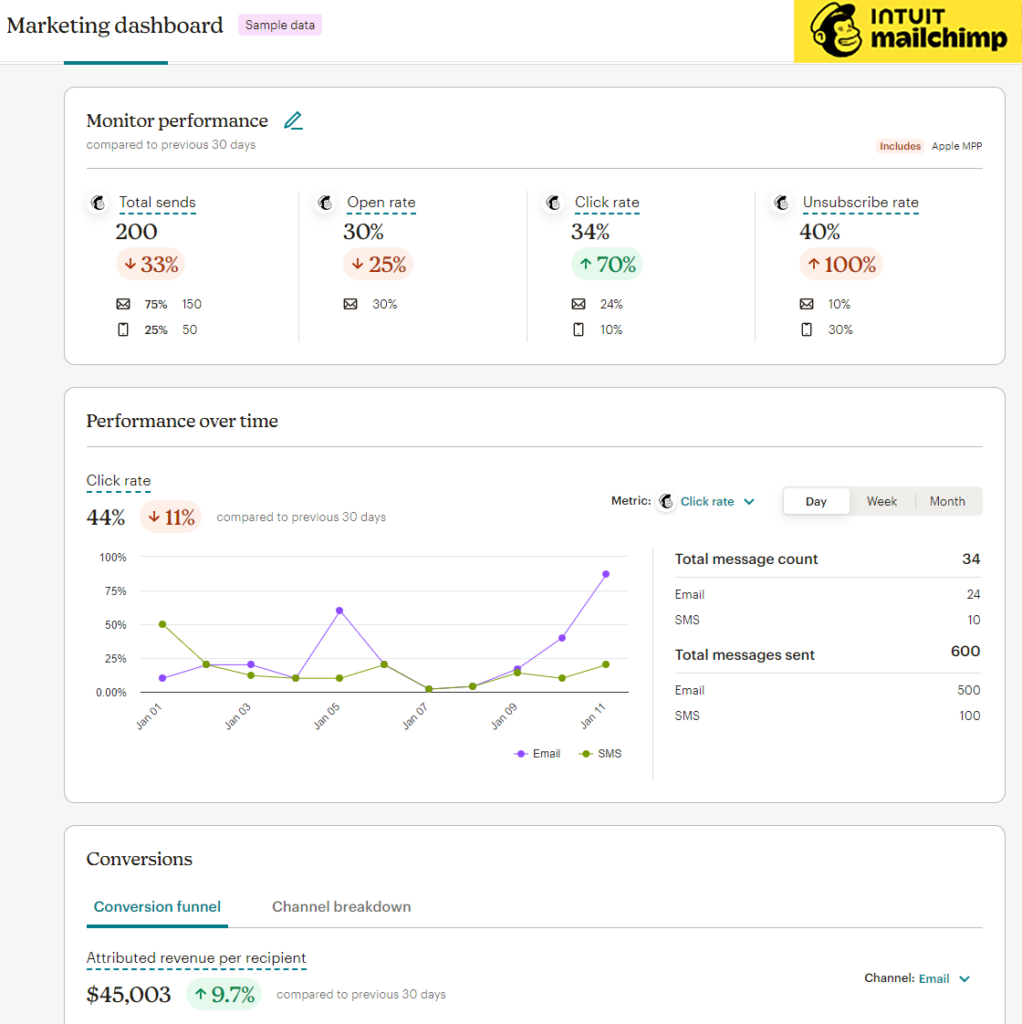
MailerLite: MailerLite provides clear and easy-to-understand deliverability reports, allowing users to monitor key metrics such as delivery rates, bounce rates, and spam complaints. While MailerLite’s reporting tools may not be as in-depth as Mailchimp’s, they are user-friendly and sufficient for most businesses, especially those with less complex reporting needs.

Conclusion: Deliverability Rates in Mailchimp vs MailerLite
When comparing the deliverability rates of Mailchimp vs MailerLite, both platforms perform exceptionally well, with high rates that ensure your emails reach your audience’s inboxes. Mailchimp offers slightly higher deliverability rates and more advanced tools for monitoring and optimizing email delivery, making it a strong choice for businesses with complex or large-scale email marketing needs. MailerLite, with its strong deliverability performance and user-friendly tools, is ideal for small to medium-sized businesses looking for a reliable and straightforward email marketing solution.
By understanding how Mailchimp and MailerLite handle deliverability, you can choose the platform that best aligns with your email marketing goals, ensuring that your messages consistently reach your subscribers’ inboxes.
Integrations and Compatibility: Mailchimp vs MailerLite
In today’s interconnected digital landscape, the ability to integrate your email marketing platform with other tools and services is crucial for streamlining workflows and maximizing the effectiveness of your campaigns. With Mailchimp vs MailerLite both offer a range of integrations and compatibility options, but they differ in scope and ease of use. In this comparison of Mailchimp vs MailerLite, we’ll explore how each platform handles integrations and compatibility with other software, helping you choose the best fit for your business.
1. Integration Availability
Mailchimp: Mailchimp is renowned for its extensive range of integrations. The platform connects with over 300 apps and services, including popular e-commerce platforms like Shopify, WooCommerce, and BigCommerce. It also integrates seamlessly with CRM systems like Salesforce, social media platforms such as Facebook and Instagram, and various analytics tools like Google Analytics. This broad compatibility makes Mailchimp a powerful choice for businesses that rely on multiple tools to manage their marketing efforts.
Mailchimp Featured Integrations

MailerLite: MailerLite also offers a solid selection of integrations, though its range is more limited compared to Mailchimp. MailerLite connects with major e-commerce platforms, such as Shopify and WooCommerce, and provides integrations with tools like WordPress, Zapier, and Google Analytics. While MailerLite covers the most essential integrations, businesses that require more specialized or extensive connections might find Mailchimp’s offerings more comprehensive.
MailerLite Featured Integrations

2. Ease of Integration
Mailchimp: Integrating with other tools in Mailchimp is generally straightforward, thanks to its well-documented API and user-friendly interface. Many integrations can be set up directly within the Mailchimp dashboard with just a few clicks. For more advanced users, Mailchimp’s API allows for custom integrations, offering flexibility for businesses with unique needs. However, the sheer number of integration options can sometimes be overwhelming, particularly for users who are less tech-savvy.

MailerLite: MailerLite is designed with simplicity in mind, and this extends to its integration process. The platform’s integrations are easy to set up, typically requiring minimal technical knowledge. MailerLite’s Zapier integration further expands its compatibility by allowing users to connect with thousands of apps, even if a direct integration isn’t available. This makes MailerLite a great option for businesses that prioritize ease of use and need a straightforward integration process.

3. E-commerce Integrations
Mailchimp: Mailchimp excels in e-commerce integrations, offering advanced features that allow businesses to sync their online stores, track customer behavior, and create targeted email campaigns based on purchase history. Mailchimp’s integration with platforms like Shopify, WooCommerce, and Magento enables users to automate product recommendations, abandoned cart emails, and post-purchase follow-ups, enhancing the overall customer experience and boosting sales.
Mailchimp for Shopify Syncs the Following Customer Events (features)
- Page viewed
- Product viewed
- Search submitted
- Product added to cart
- Payment Info submitted
- Checkout started
- Checkout completed, collection viewed
MailerLite: MailerLite also supports e-commerce integrations, though its features are more basic compared to Mailchimp. While you can still connect MailerLite to platforms like Shopify and WooCommerce, the depth of integration is somewhat limited. MailerLite focuses on essential e-commerce functionalities, such as sending automated emails based on customer actions and tracking basic sales metrics. This makes it a suitable option for small to medium-sized online stores that don’t require the extensive features offered by Mailchimp.
MailerLite E-commerce Integration Features (Shopify)
- Data synchronization
- Product blocks in newsletters
- E-commerce automation workflow triggers
- Abandoned cart emails
A Comparison of E-commerce Features Available Through Integrations
| E-commerce Feature | Mailchimp | MailerLite |
|---|---|---|
| Platform Integrations | Integrates with major e-commerce platforms like Shopify, WooCommerce, Magento, BigCommerce, and more. | Integrates with Shopify, WooCommerce, and a few others, with fewer options compared to Mailchimp. |
| Product Recommendations | AI-driven product recommendations based on user behavior and purchase history. | Basic product recommendations based on recent purchases or manual selection. |
| Abandoned Cart Emails | Fully automated abandoned cart emails with detailed tracking and customization options. | Supports abandoned cart emails, but with simpler templates and fewer customization options. |
| Purchase Follow-up | Automated post-purchase emails with upsell, cross-sell, and feedback request capabilities. | Basic post-purchase emails with limited options for upselling or requesting feedback. |
| E-commerce Reporting | Detailed sales and revenue tracking, with ROI calculations and product performance insights. | Basic e-commerce reporting, focusing on sales metrics without deep product performance insights. |
| Order Notifications | Customizable order notifications, including shipping updates and order confirmations. | Supports basic order confirmation emails; less customizable compared to Mailchimp. |
| Shoppable Landing Pages | Ability to create shoppable landing pages directly linked to product catalogs, allowing customers to purchase directly from the page. | Does not support shoppable landing pages; focuses on driving traffic to existing product pages on the e-commerce site. |
| Customer Segmentation | Advanced segmentation based on purchase behavior, order value, and product preferences, enabling personalized marketing campaigns. | Basic segmentation based on general purchase behavior, with fewer options for detailed targeting. |
| Coupon Code Integration | Easily integrates with e-commerce platforms to automatically apply and track coupon codes in email campaigns. | Supports coupon code inclusion in emails, but with more manual setup and tracking required. |
| Product Retargeting Ads | Seamless integration with social media platforms to run product retargeting ads based on customer behavior on the e-commerce site. | Limited support for product retargeting ads, primarily through basic Facebook and Instagram integrations. |
4. CRM and Social Media Integrations
Mailchimp: Mailchimp’s CRM integrations are robust, allowing users to sync data with popular CRM platforms like Salesforce and HubSpot. This integration enables businesses to manage customer relationships more effectively and personalize their marketing efforts. Additionally, Mailchimp’s social media integrations, including Facebook Ads and Instagram, allow users to run targeted ads directly from the platform, making it a comprehensive tool for multi-channel marketing.
MailerLite: MailerLite offers basic CRM and social media integrations, such as syncing with HubSpot and running Facebook Ads. While these integrations are effective for managing customer relationships and extending your reach on social media, they are not as advanced or feature-rich as those offered by Mailchimp. For businesses with simple CRM needs and basic social media marketing, MailerLite provides a solid foundation without the complexity.
| Integration Type | Mailchimp | MailerLite |
|---|---|---|
| CRM Integrations | Extensive CRM integrations, including Salesforce, HubSpot, Zoho, Pipedrive, and Microsoft Dynamics. Allows for deep integration with customer data, enabling advanced segmentation, lead scoring, and personalized marketing. | Basic CRM integrations, including HubSpot, Pipedrive, and custom integrations via API or Zapier. Primarily focuses on syncing contacts and basic data with CRM tools. |
| Social Media Integrations | Robust social media integrations, including direct integration with Facebook, Instagram, Twitter, and LinkedIn. Allows for social ad campaigns, social posting, and audience targeting directly from the platform. | Basic social media integrations, primarily through Facebook and Instagram. Supports creating and managing Facebook ads, but lacks direct integration with Twitter or LinkedIn. |
| Social Posting | Supports creating and scheduling posts directly from the platform for Facebook, Instagram, and Twitter, with detailed analytics on post performance. | Does not support direct social media posting. Focuses on email marketing and basic social ad integrations only. |
5. Custom Integrations and API
Mailchimp: Mailchimp provides a powerful and flexible API that allows developers to create custom integrations tailored to specific business needs. This is particularly useful for larger businesses or those with unique workflows that require a more personalized approach. Mailchimp’s API is well-documented and supported, making it easier for developers to build and maintain these custom connections.
MailerLite: MailerLite also offers an API, though it is more straightforward and less complex than Mailchimp’s. This makes it ideal for businesses that need basic custom integrations without the need for advanced development resources. MailerLite’s API is user-friendly and comes with clear documentation, making it accessible even to smaller businesses with limited technical expertise.
Comparison of API documentation and custom integration setup for Mailchimp vs MailerLite
| Aspect | Mailchimp | MailerLite |
|---|---|---|
| API Documentation | Mailchimp provides thorough and detailed documentation, making it easy to understand how to connect and use their tools. It includes clear instructions, examples, and guides that help even those new to APIs. | MailerLite offers simple and straightforward documentation that focuses on the basics. It’s designed to be easy to follow, making it a good choice for users who are looking for something that’s quick and uncomplicated. |
| Complexity and Flexibility | Mailchimp’s API is very flexible, allowing you to do a lot of different things, from managing contacts to running automated email campaigns. It’s great for businesses that need advanced, customized solutions. | MailerLite’s API is simpler, focusing on the essential tasks like adding new subscribers and sending emails. It’s perfect for those who need to get the basics done without much hassle or complexity. |
| Ease of Setup | Setting up Mailchimp’s API might take a bit more time because it offers so many features. However, it’s well-supported by documentation and examples, so with a little effort, you can create powerful integrations. | MailerLite’s API is quicker and easier to set up. It’s designed to get you started with the basics fast, making it ideal for small businesses or those who don’t need advanced features. |
| Security | Mailchimp uses a secure method called OAuth 2.0, which is a standard in the industry for keeping your data safe when using the API. This is especially important for larger businesses with more complex needs. | MailerLite uses API keys for security, which are easier to use but slightly less secure than Mailchimp’s method. This approach is still effective for most small to medium-sized businesses. |
| Example of Use | Example: Imagine you want to automatically send a follow-up email to customers who left items in their shopping cart. With Mailchimp, you can set this up to happen automatically, using customer data and purchase history to personalize each message. | Example: If you want to automatically add new email subscribers from your website and send them a welcome email, MailerLite makes this simple. You can set it up quickly to get the basics running without needing a lot of extra steps. |
| Support and Resources | Mailchimp has a large community and plenty of support resources, including forums and help centers where you can get advice and tips from other users and experts. | MailerLite also offers helpful resources, including guides and a supportive community, though it’s smaller and might have fewer resources compared to Mailchimp. |
Conclusion: Integrations and Compatibility in Mailchimp vs MailerLite
When comparing integrations and compatibility in Mailchimp vs MailerLite, the right choice depends on your business needs and the complexity of your marketing strategy. Mailchimp offers a vast array of integrations, making it ideal for businesses that rely on multiple tools and need advanced functionality across e-commerce, CRM, and social media. MailerLite, on the other hand, provides a more straightforward and user-friendly experience, with enough integrations to cover the essentials for small to medium-sized businesses.
By understanding the integrations and compatibility options of Mailchimp and MailerLite, you can choose the platform that best aligns with your existing tools and workflow, ensuring a seamless and efficient email marketing experience.
Customer Support: Mailchimp vs MailerLite
Customer service is a crucial aspect of any software platform, especially for businesses that rely on their email marketing tools to drive engagement and sales. Whether you’re new to email marketing or a seasoned pro, having access to reliable support can make a significant difference in your experience. In this comparison of Mailchimp vs MailerLite, we’ll explore the customer service options offered by each platform, helping you determine which one provides the support you need.
1. Availability of Support Channels
Mailchimp: Mailchimp offers a variety of customer service channels depending on your subscription level. All users, including those on the free plan, have access to the extensive knowledge base and email support. Paid users can also access 24/7 email and chat support, while higher-tier plans provide phone support. This tiered approach ensures that users with more complex needs can get faster and more comprehensive assistance.
MailerLite: MailerLite provides customer support through several channels as well, including 24/7 email support for all users, regardless of their plan. Live chat support is available during business hours, offering real-time assistance when needed. While MailerLite doesn’t offer phone support like Mailchimp, its 24/7 availability for email support makes it a reliable option for users who prefer written communication.
| Support Channel | Mailchimp Free Plan | Mailchimp Paid Plans | MailerLite Free Plan | MailerLite Paid Plans |
|---|---|---|---|---|
| Email Support | Limited availability, response times may be slower | Available 24/7 for higher-tier plans, faster response times | Available 24/7 for all users | Available 24/7 for all users |
| Live Chat Support | Not available | Available during business hours, 24/7 for higher-tier plans | Not available | Available during business hours |
| Phone Support | Not available | Available only for higher-tier plans (Premium and above) | Not available | Not available |
| Knowledge Base | Available to all users | Available to all users | Available to all users | Available to all users |
| Community Forums | Available to all users | Available to all users | Available to all users | Available to all users |
| Priority Support | Not available | Available for Premium and higher-tier plans | Not available | Not available |
2. Response Time and Quality
Mailchimp: Mailchimp’s response times can vary depending on your subscription plan. Higher-tier customers generally receive faster responses, especially through chat and phone support. The quality of support is generally high, with knowledgeable representatives who can assist with both basic and complex issues. However, some users on the lower-tier plans have reported longer wait times, particularly for email support.
MailerLite: MailerLite is known for its quick response times, particularly for email support, which is available 24/7. The live chat support during business hours also tends to be responsive and helpful. Users often praise MailerLite’s support team for being friendly, efficient, and effective in resolving issues. Despite the lack of phone support, MailerLite’s quick and consistent email and chat responses make it a strong contender for customer service.
3. Knowledge Base and Self-Help Resources
Mailchimp: Mailchimp provides an extensive knowledge base, filled with articles, guides, and tutorials that cover a wide range of topics. This resource is particularly useful for users who prefer to troubleshoot issues on their own or learn how to use the platform’s features without contacting support. Additionally, Mailchimp offers webinars and video tutorials, which are great for visual learners.
Example of Mailchimp Knowledgebase Result
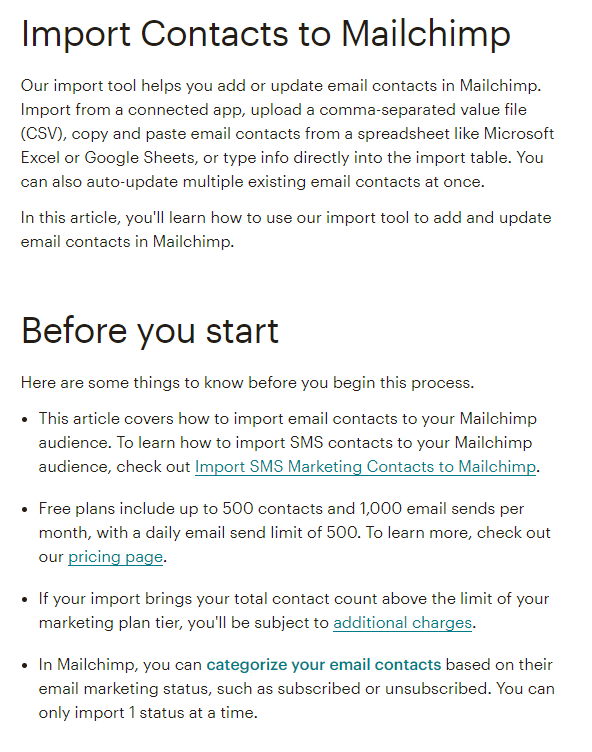
MailerLite: MailerLite also offers a robust knowledge base with easy-to-follow articles and guides. While it might not be as extensive as Mailchimp’s, it is well-organized and covers all the essential topics. MailerLite’s knowledge base is designed to be user-friendly, making it easy for even beginners to find the information they need. The platform also provides video tutorials and webinars, although these are fewer in number compared to Mailchimp.
Example of MailerLite Knowledgebase Result

4. User Community and Forums
Mailchimp: Mailchimp does not currently host an active user community. Two options for community support are the Mailchimp user group on Facebook and the Experts section in the Help area.
MailerLite: MailerLite, while smaller in scale, also fosters a sense of community among its users. The platform encourages users to participate in forums and discussion groups, where they can share their experiences and get advice. Although the community may not be as large as Mailchimp’s, it is known for being supportive and welcoming, which can be particularly beneficial for beginners.
MailerLite Community Page

5. Overall Customer Satisfaction
Mailchimp: Mailchimp’s customer service is generally well-regarded, particularly by users on higher-tier plans who have access to more comprehensive support. However, some users on the free or lower-tier plans have reported less satisfaction due to longer response times and limited access to certain support channels. Overall, Mailchimp’s support is strong, especially for businesses that require more in-depth assistance.
MailerLite: MailerLite consistently receives high marks for customer satisfaction, particularly for its responsiveness and the quality of its support team. Users appreciate the platform’s straightforward and accessible approach to customer service, as well as the 24/7 availability of email support. Even without phone support, MailerLite’s commitment to helping users succeed is evident in the positive feedback it regularly receives.
Customer Satisfaction Ratings: Mailchimp vs MailerLite

Conclusion: Customer Service in Mailchimp vs MailerLite
In the comparison of customer service between Mailchimp vs MailerLite, both platforms offer strong support, but they cater to slightly different needs. Mailchimp provides a broader range of support options, including phone support for higher-tier users, making it a good choice for businesses that require extensive assistance. MailerLite, with its 24/7 email support and highly rated customer service team, excels in providing accessible and efficient help, particularly for small to medium-sized businesses.
| Support Feature | Mailchimp | MailerLite |
|---|---|---|
| Email Support | Available for all users, 24/7 for higher-tier plans | Available 24/7 for all users, regardless of plan |
| Live Chat Support | Available for paid plans, 24/7 for higher-tier plans | Available during business hours for all users |
| Phone Support | Available only for higher-tier plans | Not available |
| Knowledge Base | Comprehensive, detailed articles and tutorials | Well-organized, straightforward guides |
| Community Forums | Not available; Facebook page | Smaller, friendly community with active forums |
| Onboarding Support | Detailed onboarding process with tutorials and tips | Simple onboarding with basic guidance |
| Priority Support | Available on premium plans | Not available |
By understanding the customer service offerings of Mailchimp and MailerLite, you can choose the platform that aligns best with your support expectations, ensuring that you have the help you need to succeed with your email marketing campaigns.
AI Capabilities: Mailchimp vs MailerLite
Artificial Intelligence (AI) has become an essential feature in many email marketing platforms, helping businesses optimize their campaigns through automation, personalization, and data-driven insights. With Mailchimp vs MailerLite both offer AI-powered tools, but they differ in the extent and sophistication of these capabilities. In this comparison of Mailchimp vs MailerLite, we’ll explore how each platform utilizes AI to enhance your email marketing efforts.
1. AI-Powered Automation
Mailchimp: Mailchimp stands out with its advanced AI-driven automation features. The platform allows users to create complex customer journeys that are guided by AI decision points. For instance, Mailchimp can analyze customer behavior and automatically trigger emails based on actions like cart abandonment, browsing activity, or purchase history. This AI-powered approach ensures that each customer receives a personalized experience, increasing the likelihood of engagement and conversion.
Example: If a customer browses a particular product category but doesn’t make a purchase, Mailchimp’s AI can automatically send a follow-up email with personalized product recommendations, increasing the chances of a sale.
MailerLite: MailerLite offers basic automation features that are easy to set up and use, but it lacks the advanced AI-driven capabilities found in Mailchimp. While MailerLite allows you to automate standard tasks like sending welcome emails, birthday greetings, and follow-up sequences, these automations are rule-based rather than driven by AI. This means that while you can create effective automated workflows, they are less dynamic and personalized compared to what Mailchimp offers.
Example: MailerLite can automatically send a welcome email to new subscribers or follow up with a discount offer after a certain period, but these actions are based on predefined rules rather than AI-driven insights.
Comparison of Use of AI with Mailchimp vs MailerLite

2. Personalization with AI
Mailchimp:
Mailchimp leverages AI to deliver a high level of personalization in email campaigns. The platform’s AI can predict customer preferences, recommend products, and optimize content to match the recipient’s interests. This level of personalization goes beyond simply using the recipient’s name; it involves tailoring the entire email experience to each individual’s behavior and preferences.
- Example: Mailchimp’s AI can determine the best time to send an email to each subscriber, ensuring that your messages are delivered when they’re most likely to be opened.
MailerLite:
MailerLite offers essential personalization features, such as dynamic content blocks and personalized subject lines, but it doesn’t incorporate AI to the same extent as Mailchimp. While you can personalize emails based on subscriber data like name, location, or purchase history, the lack of AI means that this personalization is less advanced and more dependent on manual input.
Example: You can set up personalized product recommendations in MailerLite, but these will be based on manually defined rules rather than AI-driven predictions.
A comparison of Personalized Email AI Features with Mailchimp vs MailerLite
| Feature | Mailchimp | MailerLite |
|---|---|---|
| Dynamic Content Insertion | Yes | Yes |
| Personalized Subject Lines | Yes | Yes |
| AI-Driven Product Recommendations | Yes | No |
| Send Time Optimization | Yes | No |
| A/B Testing for Content | Yes | Yes |
| Advanced Segmentation | Yes | Yes |
| Customizable Templates | Yes | Yes |
Conclusion: AI Capabilities in Mailchimp vs MailerLite
In the comparison of AI capabilities between Mailchimp vs MailerLite, Mailchimp clearly stands out with its advanced AI-driven tools that enhance automation, personalization, and data analysis. These features make Mailchimp a powerful choice for businesses that require sophisticated AI to optimize their marketing efforts. MailerLite, while more limited in its AI capabilities, offers essential tools that are easy to use and sufficient for small to medium-sized businesses looking for straightforward solutions.
Mailchimp’s AI Features Compared to MailerLite’s Features
| AI Capability | Mailchimp | MailerLite |
|---|---|---|
| AI-Driven Product Recommendations | Yes – Automatically suggests products based on user behavior and purchase history. | No – Product recommendations are manually set. |
| Predictive Analytics | Yes – Forecasts customer behavior, such as purchase likelihood and engagement. | No – Predictive analytics not available. |
| Behavioral Targeting | Yes – Uses AI to create dynamic segments based on customer actions and preferences. | No – Segmentation is manual and rule-based. |
| Send Time Optimization | Yes – AI calculates the best time to send emails to maximize open rates. | No – Emails are scheduled manually. |
| Dynamic Content Personalization | Yes – AI customizes email content for each recipient in real-time. | Yes – Supports dynamic content, but not AI-driven. |
| Advanced Segmentation Using AI | Yes – AI helps create detailed segments for precise targeting. | No – Segmentation is simpler, based on manual rules. |
| Automated Customer Journeys | Yes – AI-driven workflows adapt to customer behavior, guiding them through personalized journeys. | No – Offers basic automation without AI enhancement. |
| Content Optimization | Yes – AI provides content suggestions to improve engagement and performance. | No – Content optimization must be done manually. |
By understanding the AI capabilities of Mailchimp and MailerLite, you can choose the platform that aligns with your business goals and leverage AI to enhance your email marketing strategies.
Pros and Cons: Mailchimp vs MailerLite
Pros of Mailchimp
- Comprehensive Features
- Advanced Analytics and Reporting
- Extensive Integrations
- Scalability
Cons of Mailchimp
- Higher Cost
- Complexity
- Limited Support for Lower-Tier Plans
Pros of MailerLite
- Ease of Use:
- Affordable Pricing:
- Good Customer Support:
- Effective for Basic Needs:
Cons of MailerLite
- Limited Advanced Features:
- Fewer Integrations:
- No Phone Support:
Conclusion and Final Thoughts: Our Verdict on Mailchimp vs MailerLite
Deciding between Mailchimp vs MailerLite ultimately comes down to your specific business needs, budget, and level of experience with email marketing. Both platforms have their strengths, but they cater to different types of users and goals.
Mailchimp is a robust, feature-rich platform ideal for businesses that need advanced tools to manage complex email marketing campaigns. Its extensive integrations, AI-driven insights, and detailed analytics make it a powerful choice for those who require a comprehensive solution. However, these benefits come at a higher cost and with a steeper learning curve, which might be a consideration for smaller businesses or those new to email marketing.
On the other hand, MailerLite shines with its simplicity, affordability, and ease of use. It’s a great option for small to medium-sized businesses or individuals who need a straightforward, effective tool for managing email campaigns. While it may lack some of the advanced features found in Mailchimp, MailerLite offers all the essentials at a competitive price, making it accessible to users with varying levels of expertise.
In the end, the right choice depends on what you value most in an email marketing platform. If you need powerful, advanced features and are willing to invest in learning how to use them, Mailchimp is likely the better option. But if you prefer a simpler, more budget-friendly tool that still delivers solid performance, MailerLite may be the perfect fit for your business.
Whatever your choice, both Mailchimp and MailerLite can help you build successful email marketing campaigns that engage your audience and drive results.
FAQs
Which platform is better for beginners?
MailerLite is generally better for beginners due to its simplicity and ease of use.
Can I switch from Mailchimp to MailereLite easily?
Yes, you can switch between Mailchimp and MailerLite. Both platforms allow you to export your contact lists and import them into the other service. However, you may need to reconfigure your email templates, automation workflows, and integrations. Both platforms provide guides and support to help users transition smoothly.
Do both platforms offer a free plan?
MailerLite offers a generous free plan that includes many essential features, while paid plans start at lower prices compared to Mailchimp. Mailchimp also offers a free plan, but its pricing increases more significantly as your subscriber list grows.
Can I integrate Mailchimp or MailerLite with my e-commerce platform?
Yes, both Mailchimp and MailerLite offer integrations. However, Mailchimp provides more advanced e-commerce features. MailerLite’s e-commerce integrations are effective but more basic.

